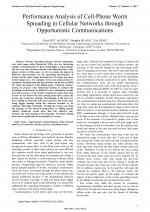| 2/2012 - 1 | View TOC | « Previous Article | Next Article » |
Performance Analysis of Cell-Phone Worm Spreading in Cellular Networks through Opportunistic CommunicationsYAHUI, W. |
| Extra paper information in |
| Click to see author's profile in |
| Download PDF |
Author keywords
opportunistic communications, delay tolerant network, 3G networks, Markov process, cell-phone worms
References keywords
mobile(14), networks(10), malware(10), sarkar(5), khouzani(5), infocom(5), infcom(5), worm(4), network(4), delay(4)
Blue keywords are present in both the references section and the paper title.
About this article
Date of Publication: 2012-05-30
Volume 12, Issue 2, Year 2012, On page(s): 3 - 8
ISSN: 1582-7445, e-ISSN: 1844-7600
Digital Object Identifier: 10.4316/AECE.2012.02001
Web of Science Accession Number: 000305608000001
SCOPUS ID: 84865306374
Abstract
Worms spreading directly between cell-phones over short-range radio (Bluetooth, WiFi, etc.) are increasing rapidly. Communication by these technologies is opportunistic and has very close relation with the social characteristics of the phone carriers. In this paper, we try to evaluate the impact of different characteristics on the spreading performance of worms. On the other hand, the behaviors of worms may have certain impact, too. For example, worms may make phones be completely dysfunctional and these phones can be seen as killed. We study the impact of the killing speed. Using the Markov model, we propose some theoretical models to evaluate the spreading performance in different cases. Simulation results show the accuracy of our models. Numerical results show that if users do not believe the data coming from others easily, the worms may bring less damage. Surprisingly, if the users are more willing to install the anti-virus software, the worms may bring bigger damage when the software becomes to be outdated with high probability. Though the worms can bring big damage on the network temporarily by killing phones rapidly, numerical results show that this behavior may decrease the total damage in the long time. Therefore, killing nodes more rapidly may be not optimal for worms. |
| References | | | Cited By |
Web of Science® Times Cited: 3 [View]
View record in Web of Science® [View]
View Related Records® [View]
Updated 3 weeks, 6 days ago
SCOPUS® Times Cited: 1
View record in SCOPUS® [Free preview]
View citations in SCOPUS® [Free preview]
[1] An intelligent approach in delay tolerant network routing, OMIDVAR, Azadeh, MOHAMMADI, Karim, TURKISH JOURNAL OF ELECTRICAL ENGINEERING & COMPUTER SCIENCES, ISSN 1300-0632, Issue , 2017.
Digital Object Identifier: 10.3906/elk-1408-114 [CrossRef]
Disclaimer: All information displayed above was retrieved by using remote connections to respective databases. For the best user experience, we update all data by using background processes, and use caches in order to reduce the load on the servers we retrieve the information from. As we have no control on the availability of the database servers and sometimes the Internet connectivity may be affected, we do not guarantee the information is correct or complete. For the most accurate data, please always consult the database sites directly. Some external links require authentication or an institutional subscription.
Web of Science® is a registered trademark of Clarivate Analytics, Scopus® is a registered trademark of Elsevier B.V., other product names, company names, brand names, trademarks and logos are the property of their respective owners.
Faculty of Electrical Engineering and Computer Science
Stefan cel Mare University of Suceava, Romania
All rights reserved: Advances in Electrical and Computer Engineering is a registered trademark of the Stefan cel Mare University of Suceava. No part of this publication may be reproduced, stored in a retrieval system, photocopied, recorded or archived, without the written permission from the Editor. When authors submit their papers for publication, they agree that the copyright for their article be transferred to the Faculty of Electrical Engineering and Computer Science, Stefan cel Mare University of Suceava, Romania, if and only if the articles are accepted for publication. The copyright covers the exclusive rights to reproduce and distribute the article, including reprints and translations.
Permission for other use: The copyright owner's consent does not extend to copying for general distribution, for promotion, for creating new works, or for resale. Specific written permission must be obtained from the Editor for such copying. Direct linking to files hosted on this website is strictly prohibited.
Disclaimer: Whilst every effort is made by the publishers and editorial board to see that no inaccurate or misleading data, opinions or statements appear in this journal, they wish to make it clear that all information and opinions formulated in the articles, as well as linguistic accuracy, are the sole responsibility of the author.



